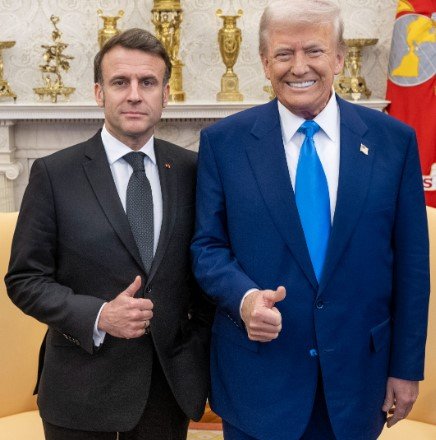French President Emmanuel Macron is pushing the European Union to consider hitting American tech giants with retaliatory measures after U.S. President Donald Trump issued fresh tariff threats over EU digital rules. This call came during a cabinet meeting in Paris on August 28, 2025, as tensions rise just weeks after a fragile trade deal between the two sides.
Trump’s Latest Tariff Threats Spark Alarm
Trump warned on August 26, 2025, that countries imposing digital taxes or regulations seen as unfair to U.S. firms could face new tariffs and export limits. He pointed to EU laws like the Digital Services Act and Digital Markets Act, claiming they discriminate against American companies and censor free speech.
This move caught EU leaders off guard, coming soon after a July 2025 agreement that set a 15 percent baseline tariff on EU exports to the U.S. Officials in Brussels had hoped the deal would ease years of trade friction, but Trump’s statement suggests the conflict is heating up again.
The U.S. has long criticized Europe’s tech rules, arguing they target giants like Google, Meta, and Amazon. Data from the U.S. Trade Representative shows the EU’s service trade surplus with America hit $100 billion in 2024, fueling Trump’s push to rebalance trade.

Macron’s Push for a Strong EU Response
During his weekly cabinet session, Macron told French ministers that Europe should not back down. He highlighted the EU’s trade deficit in services with the U.S., estimated at $250 billion annually, and suggested focusing retaliation on the digital sector.
A senior French official noted Macron’s view that the bloc’s surplus in goods, such as cars and drugs, makes it vulnerable, but striking back at U.S. tech could level the playing field. France has often led calls for tougher EU stances on trade, drawing from past disputes like the 2019 digital tax row that almost sparked tariffs on French wine.
Macron’s stance aligns with broader European sentiment. German Chancellor Olaf Scholz and EU Commission President Ursula von der Leyen have also urged unity, though they stress dialogue first.
This is not the first time Macron has advocated bold moves. In April 2025, he suggested pausing French investments in the U.S. amid earlier tariff threats, a step that rattled markets but showed Europe’s resolve.
Potential Impacts on Big Tech and Global Trade
If the EU acts on Macron’s idea, it could mean new taxes or restrictions on U.S. firms operating in Europe. Analysts predict this might affect companies like Apple and Microsoft, which earn billions from EU markets.
Recent data from the European Commission shows U.S. tech giants paid just 9 percent effective tax in Europe last year, far below local firms. Retaliation could include enforcing stricter data rules or intellectual property limits under tools like the Anti-Coercion Instrument.
- Revenue at Risk: Google and Meta could lose up to 20 percent of EU ad revenue if new measures pass.
- Market Shifts: Smaller European tech firms might gain ground, boosting competition in cloud services and social media.
- Global Ripple: Similar moves could inspire countries like India and Brazil to tighten rules on U.S. tech.
Trade experts warn of escalation. A full trade war might cut EU GDP by 0.5 percent, per a 2025 study from the Peterson Institute for International Economics.
EU’s Defense of Digital Sovereignty
Brussels has firmly defended its right to regulate tech. A Commission spokesperson said on August 27, 2025, that EU rules aim to protect consumers and ensure fair play, not target any nation.
The Digital Markets Act, effective since 2024, has already forced changes like Apple’s app store tweaks in Europe. Trump calls this bias, but EU leaders argue it’s about curbing monopolies that harm innovation.
Von der Leyen echoed this in a recent speech, noting that without such laws, misinformation and market dominance would worsen. The bloc’s approach contrasts with lighter U.S. regulations, highlighting a core divide in transatlantic ties.
Broader Context of US-EU Trade Tensions
Trade spats between the U.S. and EU date back to Trump’s first term, with tariffs on steel and aluminum in 2018. The latest deal in July 2025 paused some duties but left room for disputes.
| Key Trade Figures (2024 Data) | EU Exports to US | US Exports to EU | Trade Balance |
|---|---|---|---|
| Goods (e.g., cars, pharma) | $550 billion | $350 billion | EU surplus: $200 billion |
| Services (e.g., digital, finance) | $300 billion | $550 billion | US surplus: $250 billion |
| Total Trade Volume | $850 billion | $900 billion | US lead: $50 billion |
This imbalance drives Trump’s threats, but EU officials point out mutual benefits, like job creation from investments. Recent events, such as the U.S. Inflation Reduction Act subsidies, have also irked Europe, prompting calls for green tech countermeasures.
As negotiations continue, leaders on both sides seek to avoid a damaging war. Yet with U.S. elections looming in 2028, trade could become a key campaign issue.
What Happens Next for Transatlantic Relations
Experts believe talks will intensify in September 2025, with possible meetings at the United Nations General Assembly. Macron’s proposal might gain traction if more EU nations, like Germany and Spain, back it.
For now, markets are watching closely. Tech stocks dipped 2 percent on Wall Street after Trump’s August 26 statement, reflecting investor fears.
The outcome could reshape global tech rules and trade norms. Readers, what do you think about this escalating dispute? Share your views in the comments and pass this article along to spark discussion.








